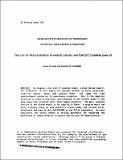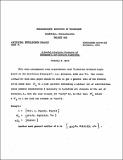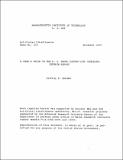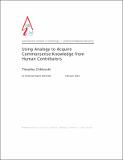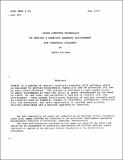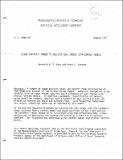Browsing Artificial Intelligence Lab Publications by Title
Now showing items 1741-1760 of 1835
-
The Use of Thread Memory in Amnesic Aphasia and Concept Learning.(note 0)
(MIT Artificial Intelligence Laboratory, 1979-09-05)We propose a new type of semantic memory, called thread memory. The primitives of this memory are threads, defined as keyed multilink, loop-free chains, which link semantic nodes. All links run from superordinate categories ... -
A Useful Algebraic Property of Robinson's Unification Algorithm
(1965-11-01)This memo presupposes some acquaintance with "A Machine Oriented Logic Based on the Resolution Principle", J.A. Robinson, JACM Jan65. The reader unfamiliar with this paper should be able to get a general idea of the ... -
A User's Guide to the A.I. Group LISCOM LISP Complier: Interim Report
(1970-12-01)The LISCOM version of the AI group PDP/6 LISP compiler is a descendant of the original Greenblatt-Nelson compiler, and is a friendly sibling to the COMPLR version maintained by Jon L. White. The compiler operates in two ... -
A User's Guide to the AI Lab: Getting Started at Tech Square
(MIT Artificial Intelligence Laboratory, 1991-08-18) -
Uses of Technology to Enhance Education
(1973-06-01)Section 1: Schematic outline of project and what we want. Hardly any intellectual content. Section 2: Statement of our goals in general terms. This statement is intended to have serious intellectual content but lacks meaty ... -
Using Analogy to Acquire Commonsense Knowledge from Human Contributors
(2003-02-12)The goal of the work reported here is to capture the commonsense knowledge of non-expert human contributors. Achieving this goal will enable more intelligent human-computer interfaces and pave the way for computers to ... -
Using Computer Technology to Provide a Creative Learning Environment for Preschool Children
(1976-05-01)TORTIS is a system of special terminals together with software which is designed to provide programming capability and be accesible for use by very young children. The system is designed to add capabilities in small ... -
Using English For Indexing and Retrieving
(1988-10-01)This paper describes a natural language system START. The system analyzes English text and automatically transforms it into an appropriate representation, the knowledge base, which incorporates the information found in the ... -
Using Enhanced Spherical Images for Object Representation
(1979-05-01)The processes involved in vision, manipulation, and spatial reasoning depend greatly on the particular representation of three-dimensional objects used. A novel representation, based on concepts of differential geometry, ... -
Using Message Passing Instead of the GOTO Construct
(MIT Artificial Intelligence Laboratory, 1978-04)This paper advocates a programming methodology using message passing. Efficient programs are derived for fast exponentiation, merging ordered sequences, and path existence determination in a directed graph. The problems ... -
Using Parallel Processing for Problem Solving
(1979-12-01)Parallel processing as a conceptual aid in the design of programs for problem solving applications is developed. A pattern directed invocation language know as Ether is introduced. Ether embodies tow notions in language ... -
Using Program Transformation to Improve Program Translation
(1987-05-01)Direct, construct by construct translation from one high level language to another often produces convoluted, unnatural, and unreadable results, particularly when the source and target languages support different ... -
Using Recurrent Networks for Dimensionality Reduction
(1992-09-01)This report explores how recurrent neural networks can be exploited for learning high-dimensional mappings. Since recurrent networks are as powerful as Turing machines, an interesting question is how recurrent networks ... -
Using Special-Purpose Computing to Examine Chaotic Behavior in Nonlinear Mappings
(1989-09-01)Studying chaotic behavior in nonlinear systems requires numerous computations in order to simulate the behavior of such systems. The Standard Map Machine was designed and implemented as a special computer for performing ... -
Using Structural and Functional Information in Diagnostic Design
(1983-06-01)We wish to design a diagnostic for a device from knowledge of its structure and function. the diagnostic should achieve both coverage of the faults that can occur in the device, and should strive to achieve specificity ... -
Using Synthetic Images to Register Real Images with Surface Models
(1977-08-01)A number of image analysis tasks can benefit from registration of the image with a model of the surface being imaged. Automatic navigation using visible light or radar images requires exact alignment of such images ... -
Using the EUTERPE Music System
(1971-10-01)This memo describes the practical implementation of programs written in the language EUTERPE. Details of this language are given in the author's thesis (A Parallel Processing Model of Musical Structures) and will not ... -
Using the PUMA System
(MIT Artificial Intelligence Laboratory, 1985-04)This document describes the operation of the Lisp Machine interface to the Unimation Puma 600 Robot Arm. The interface is evolved from a system described in an earlier paper, and much is the same. However, the under-lying ... -
Using the Vidisector and the Store Picture Facility
(MIT Artificial Intelligence Laboratory, 1972-06)The stored picture facility (FAKETV) allows LISP users, and to some extent machine language users, to access a library of stored images rather than live vidisector scenes. The vidisector functions in LISP have been slightly ... -
Utilizing Dynamic Stability to Orient Parts
(1988-02-01)The intent of this research is to study the dynamic behavior of a solid body resting on a moving surface. Results of the study are then used to propose methods for controlling the orientation of parts in preparation ...
